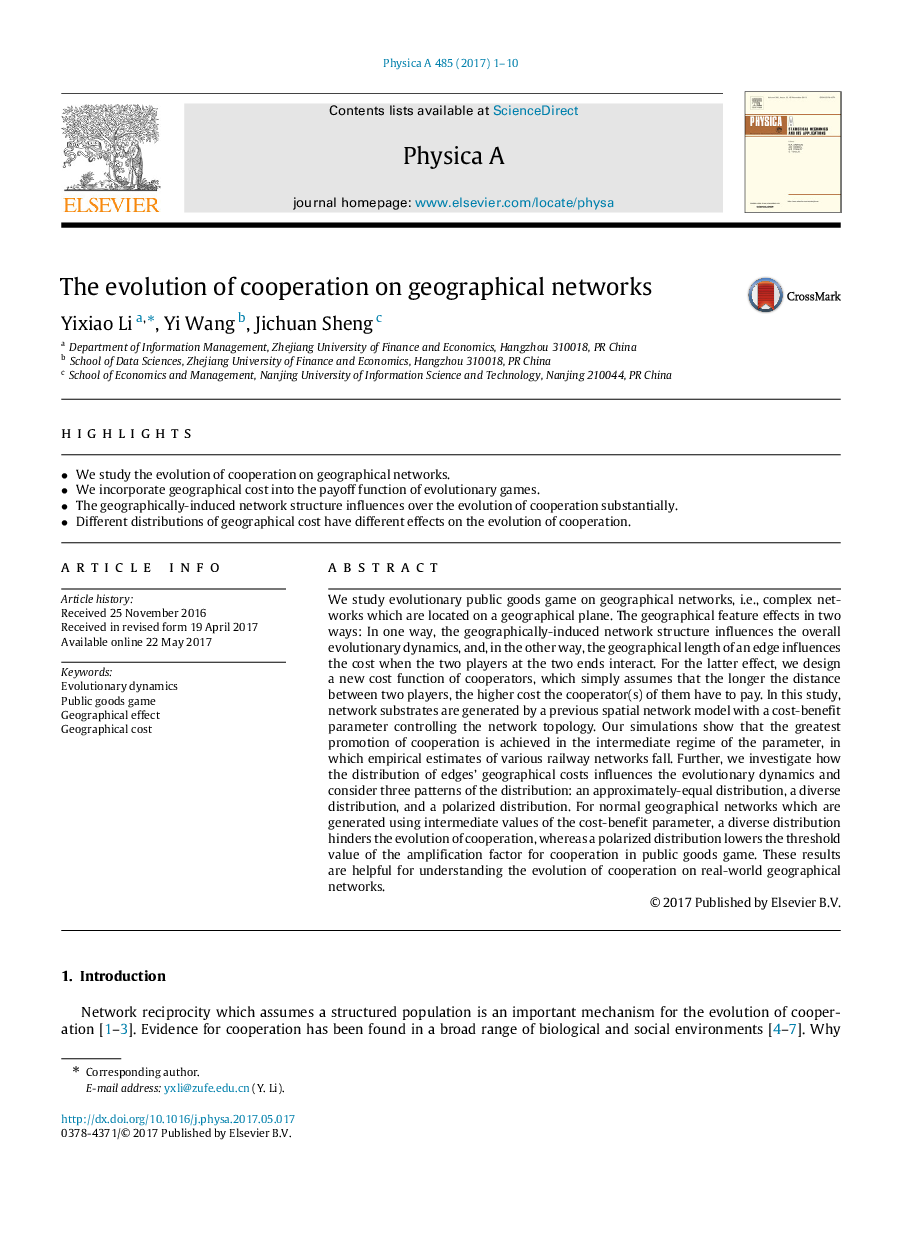| کد مقاله | کد نشریه | سال انتشار | مقاله انگلیسی | نسخه تمام متن |
|---|---|---|---|---|
| 5102515 | 1480088 | 2017 | 10 صفحه PDF | دانلود رایگان |
عنوان انگلیسی مقاله ISI
The evolution of cooperation on geographical networks
ترجمه فارسی عنوان
تکامل همکاری در شبکه های جغرافیایی
دانلود مقاله + سفارش ترجمه
دانلود مقاله ISI انگلیسی
رایگان برای ایرانیان
کلمات کلیدی
دینامیک تکاملی، بازی کالاهای عمومی، اثر جغرافیایی، هزینه جغرافیایی،
ترجمه چکیده
ما بازی کالاهای تکاملی عمومی را در شبکه های جغرافیایی، یعنی شبکه های پیچیده که در یک نقشه جغرافیایی واقع شده اند، مطالعه می کنیم. جلوه های جغرافیایی به دو صورت امکان پذیر است: به طور یکنواخت، ساختار شبکه ناشی از جغرافیایی بر روی پویایی تکاملی کلی تاثیر می گذارد، و از سوی دیگر، طول جغرافیایی یک لبه بر هزینه تاثیر می گذارد، زمانی که دو بازیکن در دو انتها به یکدیگر متصل می شوند. برای اثر دوم، ما یک تابع هزینه جدید از همکاری ها را طراحی می کنیم، که به سادگی فرض می کند که فاصله بین دو بازیکن طولانی تر باشد، هزینه همکاری (ها) آنها را پرداخت می کنند. در این مطالعه، زیربنای شبکه توسط یک مدل شبکه فضایی قبلی با پارامتر هزینه-سود و کنترل توپولوژی شبکه ایجاد شده است. شبیه سازی های ما نشان می دهد که بزرگترین ترویج همکاری در رژیم میانی پارامتر، که برآوردهای تجربی شبکه های مختلف راه آهن را کاهش می دهد، به دست می آید. علاوه بر این، ما بررسی می کنیم که چگونه توزیع هزینه های جغرافیایی لبه ها بر پویایی تکامل تاثیر می گذارد و سه الگو توزیع را در نظر می گیرد: توزیع تقریبی برابر، توزیع متنوع و توزیع قطبی. برای شبکه های جغرافیایی طبیعی که با استفاده از مقادیر متوسط پارامتر هزینه-سود تولید می شوند، توزیع متنوع مانع تکامل همکاری می شود، در حالیکه توزیع قطبی شده مقدار آستانه تقویت کننده را برای همکاری در بازی های کالاهای عمومی کاهش می دهد. این نتایج برای درک تکامل همکاری در شبکه های جغرافیایی در دنیای واقعی مفید است.
موضوعات مرتبط
مهندسی و علوم پایه
ریاضیات
فیزیک ریاضی
چکیده انگلیسی
We study evolutionary public goods game on geographical networks, i.e., complex networks which are located on a geographical plane. The geographical feature effects in two ways: In one way, the geographically-induced network structure influences the overall evolutionary dynamics, and, in the other way, the geographical length of an edge influences the cost when the two players at the two ends interact. For the latter effect, we design a new cost function of cooperators, which simply assumes that the longer the distance between two players, the higher cost the cooperator(s) of them have to pay. In this study, network substrates are generated by a previous spatial network model with a cost-benefit parameter controlling the network topology. Our simulations show that the greatest promotion of cooperation is achieved in the intermediate regime of the parameter, in which empirical estimates of various railway networks fall. Further, we investigate how the distribution of edges' geographical costs influences the evolutionary dynamics and consider three patterns of the distribution: an approximately-equal distribution, a diverse distribution, and a polarized distribution. For normal geographical networks which are generated using intermediate values of the cost-benefit parameter, a diverse distribution hinders the evolution of cooperation, whereas a polarized distribution lowers the threshold value of the amplification factor for cooperation in public goods game. These results are helpful for understanding the evolution of cooperation on real-world geographical networks.
ناشر
Database: Elsevier - ScienceDirect (ساینس دایرکت)
Journal: Physica A: Statistical Mechanics and its Applications - Volume 485, 1 November 2017, Pages 1-10
Journal: Physica A: Statistical Mechanics and its Applications - Volume 485, 1 November 2017, Pages 1-10
نویسندگان
Yixiao Li, Yi Wang, Jichuan Sheng,
